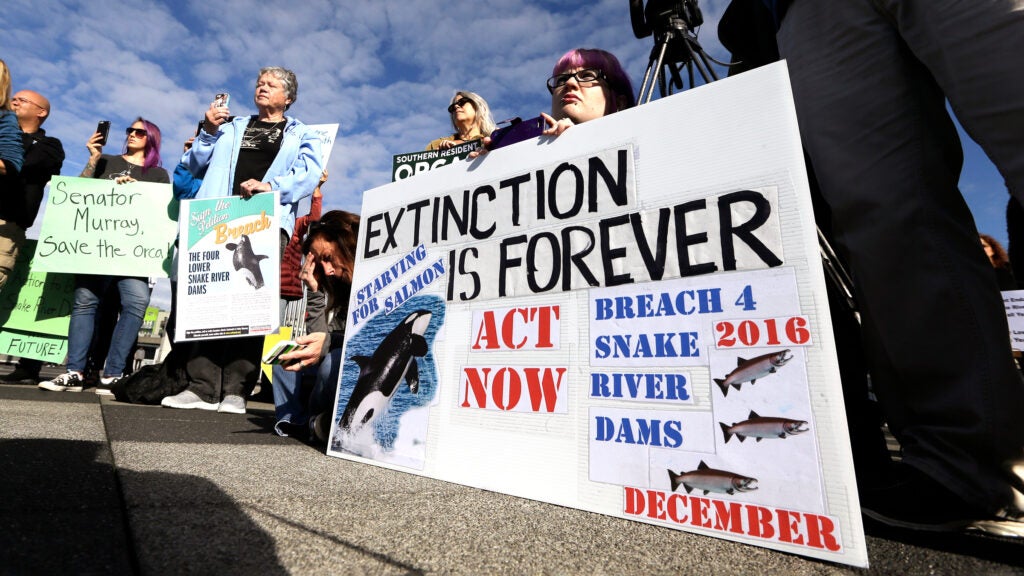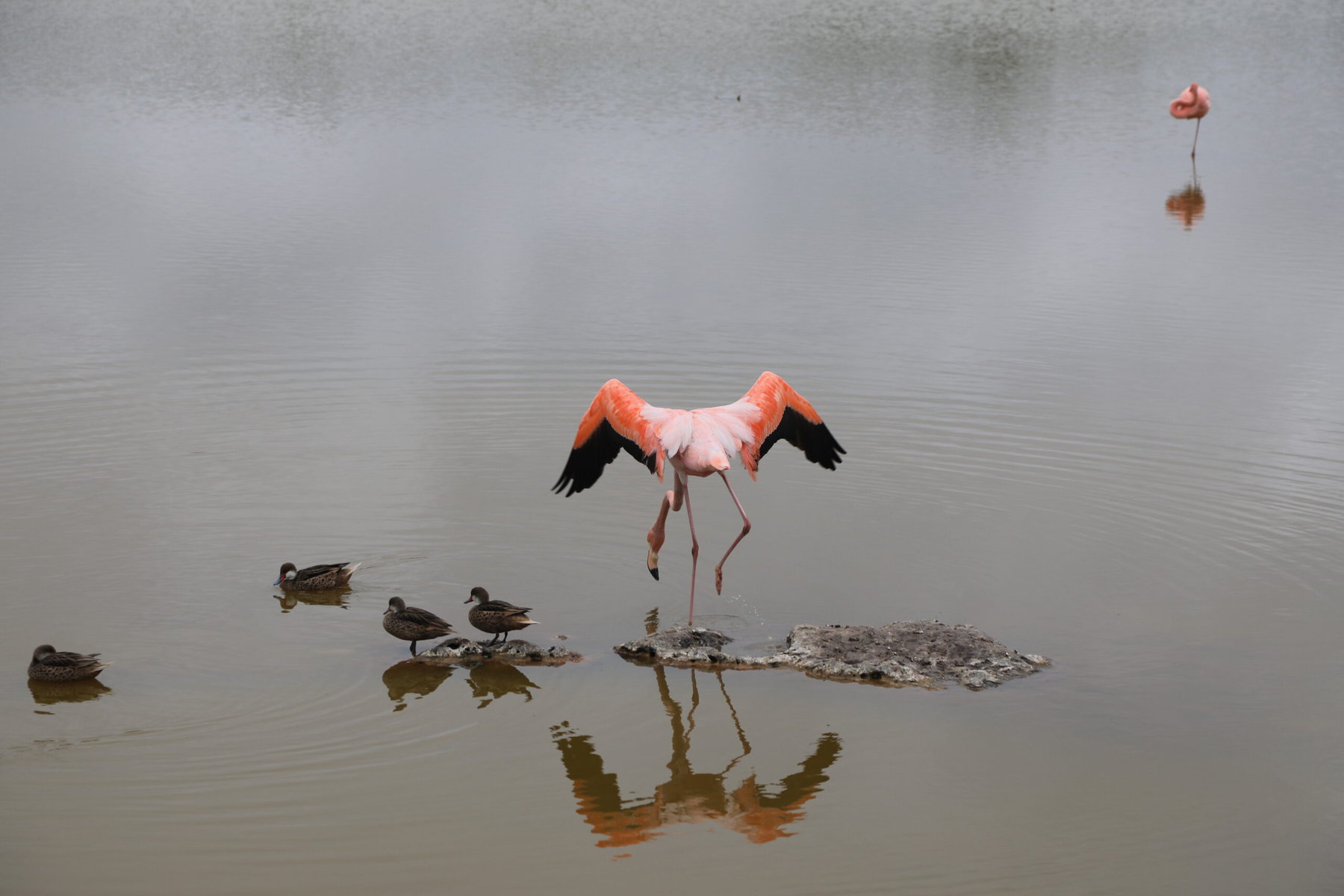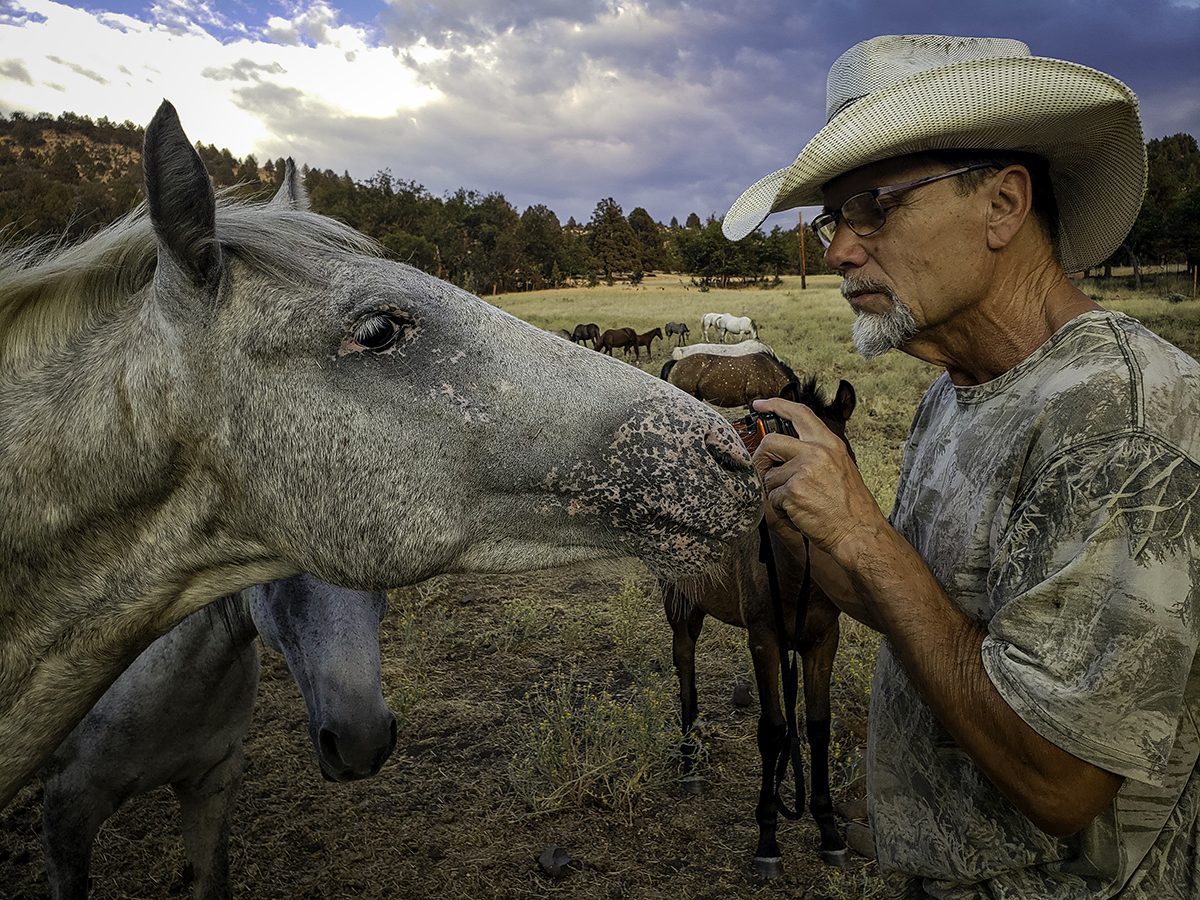Because of how it often seems like everything is getting worse—climate change, habitat loss, and the sixth great extinction—it can be tough to remember that some things used to be even more terrible than they are right now.
ARCHIVAL NEWSCASTS: Pesticides may indeed represent a grave threat to mankind.
The biggest most desperate smog investigation.
Bacteria have been estimated at 1500 times human safety level.
Peter: Even if we go back to the “good old days”—by which I mean the decades after World War II—ecologically, it wasn’t actually all that great. Rivers were catching on fire from spilled oil and dumped chemicals. City skies were dense with smog. Acid rain fell from clouds, eating away at stone buildings.
But from those ashes and toxic fumes was born the modern day environmental movement.
ARCHIVAL NEWSCAST: Earth day demonstrations began in practically every city and town in the United States this morning, the first massive nationwide protest against the pollution of the environment.
Peter: One of the big rallying points in this environmental awakening were animals. Thanks to things like Rachel Carson’s book Silent Spring and the best-selling album Song of the Humpback Whale, people started to realize that things like whales, alligators, and even the bald eagle were facing existential threats.
Because of this increased awareness, throughout the 60s and early 70s, Congress passed most of the environmental laws we still depend on today. The Clean Water Act, Clean Air Act, and a series of laws to protect animals, culminating in the Endangered Species Act, which was signed into law 50 years ago this month.
And looking back, the amazing thing was, there was very little opposition to these laws. The Senate, for example, passed The Endangered Species Act 94-0. Talk about the good old days.
The reason it had such overwhelming support was that the Endangered Species Act was designed to protect things most people already loved, like blue whales and peregrine falcons and grizzly bears. This new law was only supposed to hurt, I don’t know, the whaling industry. And the makers of the chemical DDT, which was killing birds left and right. Essentially, these were the bad guys from Captain Planet.
What it has become, however, is a law that touches almost every sector of industry, and inadvertently shapes the daily lives of millions of Americans. It’s one of the strongest environmental protections we have and may shape the future of our whole planet. But that future is one that the writer’s of the Act couldn’t have imagined.
My name is Peter Frick-Wright, this is the Wispria Podcast, and today we’re looking at a surprisingly interesting piece of legislation, for something so old and established.
I think most of us take it for granted. But one of the things that’s become evident lately, is that the Endangered Species Act was, in a lot of ways, written for a world a few degrees cooler than the one we’re increasingly living in. So producer Aaron Scott started wondering, “is the Endangered Species Act out of date? Can it handle a changing climate? And how did we get to this point?” And the answers he found to those questions took the form of three stories, about three animals: a fish, a bird, and a bear. Here’s Aaron.
Aaron Scott: The 20th century was all about building dams. It was like we couldn’t look at a river without thinking, y’know what would improve this? A giant concrete wall plugging it up.
Daniel Rohlff: We would just build dams all over the place. Um, sometimes for navigation purposes, sometimes for irrigation purposes, sometimes for kind of harebrained schemes that primarily brought federal construction dollars to a region.
Aaron: Daniel Rohlff is a professor at the Lewis and Clark Law School who’s written a lot about the Endangered Species Act. And he says, one of these dams proved to be the Act’s first big test. The Tellico Dam.
Daniel: And they concocted this sort of harebrained scheme to build this dam, create this reservoir, and then the federal government would have condemned all of the private land around to build the reservoir.
Aaron: The Tellico dam would plug the Little Tennessee River, this beautiful winding waterway that was sacred to Cherokee people. The valley the dam would flood was full of fertile soils that had supported generations of farmers. But that didn’t deter the Tennessee Valley Authority, or the TVA, from using eminent domain to force people to move, bulldozing their houses, and starting work on the dam in 1967. The stated goal was to make a bunch of brand new waterfront property.
Daniel: And so then the federal government could sell the land to the Boeing company that was going to build a model city on the banks of the lake and attract all sorts of people and vacationers and tech companies and all sorts of things. None of that ended up ever happening, but that was the idea.
Aaron: Lest you think this was a backroom conspiracy, it wasn’t. The chairman of the TVA himself talked about it openly in the New York Times.
Of course, the tribe and the farmers tried to stop all this. But they couldn’t, despite appealing all the way to the Supreme Court.
Daniel: At that point, a biologist found a small fish, which he named the snail darter, um, after its preferred food.
Aaron: It’s two to three inches long. looks like a glorified minnow.
Daniel: The people that involved in that litigation say, you know, it would have been a whole different thing if, if the fish had been named the Tennessee darter or something, you know, so that sounded a little, um, more appealing. But it was called the Snail Darter and at that point it was thought that this portion of Little Tennessee River that was going to be inundated was its last habitat on Earth.
Aaron: So in 1975, the US Fish and Wildlife Service listed the Snail Darter as an endangered species.
The Endangered Species Act has a number of components. It prohibits all people from killing, harassing and selling threatened and endangered species, or from doing anything that affects their habitat in a way that could result in injury or death. This applies even on private land.
But mostly, the act applies to the federal government. It requires it to monitor species and come up with recovery plans. And most importantly, it includes a section that bars federal agencies from doing anything that might threaten a species survival, such as changing or destroying its habitat.
Daniel: Section 7 says, okay, federal agency, you can’t do anything that jeopardizes the continued existence of a listed species. And here, you had a species that not only was going to be jeopardized, But everyone thought that it would be extinguished by completion of this dam.
Aaron: The snail darter was derided in the press. It was widely seen as a silly idea, that some tiny fish no one had heard of should derail a dam that the federal government had already invested nearly 100 million dollars in constructing.
Daniel: When the Corps of Engineers, saw that, you know, is running into endangered species problems, its response was to build the dam faster, try to get it complete. And say, Oh court, you know, you don’t have to worry about it now because this, this fish is toast.
Aaron: Lucky for the Snail Darter, they didn’t finish fast enough, and a young professor at the University of Tennessee Law school took up the case. With the help of some students, he sued the Tennessee Valley Authority using the Endangered Species Act, and fought all the way to the Supreme Court.
The question at the heart of the case was did the law really mean a fish was more important than a dam?
Daniel: And the answer from the Supreme Court was a resounding yes.
Aaron: In its ruling, the Court described the endangered Species Act as quote “the most comprehensive legislation for the preservation of endangered species ever enacted by any nation.” It’s become one of the most important environmental law rulings in US history.
Daniel: Now the interesting thing at that point is one of the dissenting justices in the case said, I think this result is silly, and I’m sure that Congress will go back and change the statute in response to our decision. And Congress, in fact, did do that almost immediately.
Aaron: But instead of weakening the law, What Congress did was add a release valve. They created a committee composed of high level national and state officials that could conduct a hearing and potentially grant exemptions to the law.
Daniel: The Endangered Species Committee, which of course, quickly became nicknamed the God Squad because theoretically it has the power of to consign a species to extinction.
Aaron: And the Tellico Valley Authority was the first to call in the God Squad, in 1979.
Daniel: The Endangered Species Committee looked carefully at the Tellico Dam, which at that point was, um, almost 95 percent complete. And the findings of that committee were that the money that it would cost to finish the dam, the 5 percent of the project cost still to be spent, um, was more than the value of the whole project.
Its findings said this dam was essentially worthless.
Aaron: And so the Endangered Species Act won the day. A hare brained scheme, backed by powerful interests, was brought to its knees by a snail-snacking fish. And the case made it very clear to the country that the law wasn’t just about saving big beloved animals; it was about protecting all creatures, great and small.
Except, that’s not how politics works. After their loss in court,the Tennessee Congressional delegation inserted a measure into an appropriations bill to overrule the law and continue construction on the dam, and President Carter reluctantly signed it.
Daniel: Today the Tellico Dam exists. But, kind of the good part of the story is that the snail darters did not become extinct.
Aaron: That’s because, before the dam was finished, biologists transplanted the fish from the LIttle Tennessee to other rivers in the basin, and later discovered they lived in a few tributaries beyond that. They were even delisted in 2022.
Daniel: It’s sort of a good news, bad news story
Aaron: Bad news is, because of all the Tennessee Valley dams, oxygen levels in the water run dangerously low at certain times of year.
Daniel: And so in order to ensure these fish continue to live, we literally have to pump dissolved oxygen into the rivers. And if we didn’t do that, they may well become extinct.
Aaron:So an endangered fish that nearly stopped the construction of a dam, turns out, wasn’t actually at risk of going extinct from that single dam. But that dam added up with all the rest means that same fish now requires regular support in order to survive.
Which raises a big question for Dan. What does recovery look like in the 21st century? If something is alive only due to constant human intervention, is that recovery? That’s after the break.
[advertisement]
Aaron: So the snail darter saga made two things clear. First, the Endangered Species Act was very powerful, but second, if Congress didn’t like it, it’d be damned if it was going to follow its own law. That became even more clear as the act went from being disliked by some Tennessee politicians to disliked by an entire political party. And the story of how that happened, takes wing with a motley owl.
Daniel: Here in the Pacific Northwest, the timber industry is really significant.
Aaron: If we step back again to that era after World War II, America was booming, and all those new sprawling suburbs needed wood. A lot of wood. And the forests of the northwest were full of it. We’re talking giant trees, from Douglas Fir to the fabled redwoods. They could tower more than 300 feet and stand up to 15 feet wide.
Daniel: We mostly looked at old growth forests as sort of decadent. That was a term that was actually used. Meaning like, Oh, you know, they’re just kind of old. They’re sitting around. Not going to, um, a worthwhile purpose. And so they’re kind of highest and best use was to chop those trees down, and then we can grow new, vigorous young forest and you chop them down, you know, and the idea was literally a tree farm.
Aaron: So for years, the Forest Service sold off sections of trees in national forest, logging companies employed local loggers to cut them down, and taxes flowed to local towns and schools. Timber was the life blood of many rural communities across the Northwest.
That is, until some scientists and environmentalists started to realize that these last grove’s of old growth trees were not decadent, they were unique. And if people didn’t act fast, they were going to disappear forever.
ARCHIVE NEWS REPORTER: Logging crews arrived at 5:30 this morning to find 30 protestors who sealed off entrance to the site.
Aaron: Throughout the 1980s, activists tried every tactic they could think of to slow down the chainsaws.
ARCHIVE NEWS PROTESTOR: The Forest Service is cutting too fast. They’re too greedy. We want to slow things down.
Aaron: They protested logging sales, chained themselves to trees and went to court.
ARCHIVE NEWS REPORTER 2: Loggers and environmentalists in Oregon are locked into a battle over a stand of ancient trees.
Aaron: But for the most part, they lost. It wasn’t until a young graduate student at Oregon State University started studying old-growth that anyone realized there were species that only lived in these old, mature forests. Most notably, the Northern Spotted Owl.
Daniel: And so finding a species whose fate was very closely tied to this disappearing ecosystem, provided a pretty significant legal tool.
Aaron: The idea was to use the owl to protect the forest. Basically to turn the Endangered Species Act into an Endangered Ecosystems Act. But the Reagan administration leaned on Fish and Wildlife to reject the petition and rule the bird was not endangered.
Daniel: That decision, I think it’s pretty safe to say, was largely politically motivated, because the biology was fairly clear. But the Reagan administration was sort of very pro business, um, and was reluctant to do anything that could have any impact on this important, um, economic sector in the Pacific Northwest.
Aaron: The law is clear that science, and not economics, is the only thing that should be considered in whether to declare a species threatened or endangered. But it took three years in court to get the Spotted Owl listed in 1990.
ARCHIVE NEWS REPORTER: The Fish and Wildlife Service says there is absolutely no question the spotted owl is a threatened species.
Aaron: By that time, another law had actually been used to halt most logging in national forests,
ARCHIVE NEWS ANCHOR: A federal judge in Seattle last night blocked timber sales in national forests in three northwest states.
Aaron: But the Endangered Species Act, and the Northern Spotted Owl,took the blame.
And while the snail darter decision only impacted a small number of agencies and businesses, the cutback in federal logging sales to protect the northern spotted owl impacted a whole region.
ARCHIVE NEWS REPORTER: Environmentalists are accused of turning the Endangered Species Act into a terrorist weapon to kill off timber industry.
MILL OWNER: It’s a disaster. They’re going to shut the mills like this in Oregon and Washington down. Period.
MILL OWNER 2: I guess it comes down to what’s most important: the survival of human beings, or the survival of spotted owls. I think that’s really is what we’re looking at.
Aaron: It’s a question that’s played out over and over now in similar fights over everything from salmon to sage grouse to wolves.
Daniel: The law was increasingly politicized, you know. Certainly for the last 30 years, we’ve seen, you know, the conservative side of the political ledger, especially Republicans, largely trying to weaken the Endangered Species Act. Whereas, Democrats are trying to appropriate more funds to allow it to be implemented more effectively or even try to strengthen the statute.
Aaron: For the most part, neither side has tipped the scales. The letter of the law remains strong, while the implementation remains largely underfunded, which means a lot of species are on a waiting list to get protections and recovery plans.
As for the owl, it’s another good news bad news story. Most of the remaining mature and old growth forests on federal land have been protected. But the owl itself is struggling, in large part due to a new threat: the barred owl, an invasive species from the east coast that’s outcompeting Spotted Owls on their home turf.
Daniel: So, today there’s real concern that barred owls could potentially cause the extinction of northern spotted owls.
Aaron: Like the snail darter, one of the few ways to protect the owl is through constant human intervention.
The US Fish and Wildlife Service has actually conducted fairly successful tests of controlling barred owl populations in order to protect northern spotted owls. And by, when I say controlling, I mean going out and literally killing, shooting, um, barred owls to try to benefit northern spotted owls. And that, of course, raises just another sort of difficult 21st century question of, you know, do we want to prevent the extinction of northern spotted owls um, by going out and perpetually shooting and killing barred owls.
Aaron: Killing one animal to save another might seem shocking, but it’s pretty common. A fifth of all endangered species require it, from killing ravens to protect snowy plovers to poisoning coyotes to protect black-footed ferrets. And it’s just going to get worse as climate change and human sprawl opens new habitat to more invasive species.
For Dan, the spotted owl and the snail darter are examples of a way that the Endangered Species Act has evolved. When it was passed in 1973, it was supposed to be an emergency room.
Daniel: Where, oh no, there’s, this species is really in trouble. You know, we take it into the emergency room. We treat it. We protect it. We ensure that it can survive on its own in its natural environment. And then it’s recovered and we take it off the threat and endangered list. We release it from the hospital.
Aaron: But due to the overwhelming ways that humans have transformed this planet, that idea has changed. The act is no longer like an ER that can treat and release its patients. Now it’s a life support system.
Daniel: Where you have to have machines and intervention at all times rather than a functional natural environment.
Aaron: But as the atmosphere continues to heat up and everything has to adapt, the question becomes, when does life support turn into hospice care?
If climate change has a poster animal, it’s the polar bear. Floating around on rapidly melting ice.
Daniel: With those declines, we not only have seen polar bear declines, but, you know, the future of polar bears looks pretty grim.
Aaron: So in the early 2000s, environmental groups petitioned to get polar bears listed. But that listing raised an interesting question. If the Endangered Species Act protected habitat, and the bear’s habitat was being lost to global warming, did the Endangered Species Act apply to anything that released greenhouse gases?
This scenario would essentially shut down the economy. And the George W. Bush administration did not want to do that.
Daniel: Well, if every time a federal agency did something that resulted in more greenhouse gas emissions, it triggered all of those procedural and substantive protections, that’s a huge deal.
Aaron: You can just imagine the lawsuits.
Say a utility wants to build a power plant in Arizona. Or a city in Iowa wants to approve a new landfill.
Now environmentalists could fight those or any project anywhere by saying their emissions will negatively impact polar bears. So the administration asked the Department of the Interior to find a workaround.
Daniel: The agency came up with this idea that, well, you know, emission of greenhouse gasses and impacts to polar bears, the connection between those two things is just too remote.
Aaron They said that the problem was collective global emissions over decades and that science couldn’t separate that this one particular power plant over here was harming that one particular polar bear over there.
Daniel: And so, because you can’t clearly connect that bear and that plant, we can just sort of ignore all greenhouse gas emissions.
Aaron: So essentially, the Bush administration took climate change off the table, and the following administrations all followed suit.
But that’s starting to change.
The development of what’s called “Attribution science,” which allows researchers to link climate change to specific things like heat waves and melting ice, is helping the bear’s case. In particular, a study published in August that linked incremental increases in carbon emissions to specific decreases in polar bear habitat.
Daniel: So you can literally say, okay, as a result of this amount of carbon emissions, you know, even these bears will be more adversely affected than these other bears.
Aaron: But the thing is, even if greenhouse gasses are taken into account, there’s still a fundamental flaw in the way the Endangered Species Act has been implemented. Every action that’s evaluated for its impact on an endangered species is evaluated on its own, not as part of a bigger picture.
Daniel: So, essentially your question is, does this one timber sale, maybe it’s a big timber sale, you know, does this one big timber sale jeopardize the entirety of northern spotted owls across the region. Or the entirety of a salmon population or something like that. Which of course is almost never the case. You know, there’s almost never one project that’s going to jeopardize an entire species.
Aaron: You can think of it in terms of the straw that breaks the camel’s back. Each project, on its own, cuts down just a small amount of forest or puts just a small amount of greenhouse gasses, relatively speaking, into an enormous atmosphere. But no one’s keeping track of what they’re adding up to, and when we’ll hit that final straw.
To a large extent, the Endangered Species Act has been a stunning success. There are now more than 1,500 animals listed as threatened and endangered, and one widely cited study credits the law with saving 99 percent of them from extinction.
A few of the listings are full-scale wins. Fifty-four animals have been deemed to have recovered under the law, including humpback whales, alligators and grizzly bears. And you can now see that American mascot, the Bald Eagle, soaring across the country again. That was never a given.
Then there are a lot of good news, bad news stories. Species like the California condors and the black-footed ferret. Both were down to just a couple dozen animals, and the law helped bring them back from the edge of extinction. Now a couple hundred of each are kicking along, although they need a lot of help from humans.
The challenge moving forward will be how to define recovery in a quickly changing world.
Is it enough that an animal is alive? Even if it’s just in a small, isolated population that relies on human life support?
Or does recovery mean a functioning natural environment? One that will keep functioning in a warmer world?
Basically, when it comes to the Endangered Species Act the question is, is this 20th century piece of legislation up to solving 21st century problems?
To do so, it will have to adapt, in permanent ways. We’re going to have to think not in terms of protecting individual species, but entire ecosystems, to protect not just the endangered animals that live there now, but the ones that will migrate there as they’re pushed northward and to higher elevations by rising temperatures.
Some scientists say that if we’re going to avoid widespread species loss and the worst consequences of climate change, we need to protect about 30 percent of U.S. land, and 30% globally, by 2030. And there’s currently an international push to do this.
In other words, after 50 years grappling with the largest, most comprehensive legislation for the preservation of endangered species ever enacted by any nation, what we’ve learned in that time is that we need to think even bigger.

















